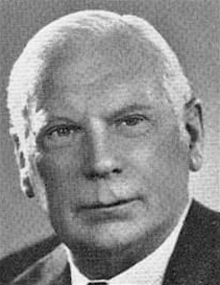
Thomas Penberthy Bennett [also known as Sir Thomas Penberthy Bennett; and as Sir Thomas Bennett] was born in London, England on 14 August 1887. His training as an architect began in 1901 when he entered the drawing office in the Architects' Department of the London & North Western Railway (LNWR) in Euston, London. He also attended classes at Willesden Polytechnic from 1902 to 1906; Regent Street Polytechnic under Albert Edward Richardson (1880-1964) from 1906 to 1909; and the Royal Academy Schools in London from 1909 to 1914. He also took lessons in drawing at Heatherley's School of Fine Art in London. In 1911 he left the LNER in 1911 to work in H. M. Office of Works.
Bennett qualified as an architect in 1912 and was elected an Associate of the Royal Institute of British Architects (ARIBA) in 1912. After service in World War One, he joined the office of Méwès & Davis as a chief assistant in 1919. Eighteen months later he left to set up his own practice in London in partnership with James Davidson Hossack (1892-1975) as Bennett & Hossack. It is unclear how long the partnership existed as soon after this Bennett established another architectural practice, T. P. Bennett & Son in London
In the early 1920s Bennett was also appointed head of the Department of Architecture, Surveying and Building at the Northern Polytechnic. He resigned academic his post in 1929 in order to devote more time to his practice. Over the next ten years he designed numerous building including banks, cinemas, residential blocks, local authority housing, shops and establishments for the Royal Navy.
During World War Two, he was employed by the Ministry of Works in the overseeing of the construction of airfields, hospitals, ordnance factories, prisoner-of-war camps, etc.
Following the war, he served as chairman of Crawley New Town and of Stevenage New Town. Throughout these years he maintained his private practice.
Bennett was elected a Fellow of the Royal Institute of British Architects (FRIBA) in 1922 and was knighted in 1946. He died at his home in Highgate, London on 29 January 1980.
Extension to Commonwood House, Chipperfield; factory for Messrs. David Allen and Sons, Wandsworth; houses, etc., at Angmering; Richmond; Merstham; Peacehaven; Surbiton: Pontardawe and Alltwen (S. Wales); Bath; Mangotsfield, Bristol; St. John's Wood; Kenley; Hove, etc.; shops in Wigmore Street and Holles Street, London; and in Accrington; business premises in Moorgate, etc. [Source: Who's Who in Architecture 1926]
______
Later work by Bennett and his practice included the Odeon cinema at Haverstock Hill, Hampstead, London (1934); Dorset House at Marylebone, London (1934); Marsham Court, a ten-storey block of flats in Westminster, London (1938); The Paviour's Arms in Westminster, London (1938); 'Hilcrest' housing scheme, Highgate, for Hornsey Borough Council, London (1946); a wool-knit factory in Liverpool (1946); a factory for S. Smith and Sons (Clockmakers) in Cheltenham (1948); the Odeon cinema in St. Helier, Jersey (1951); an old people's home, Derby (1951-1956); the Springfield, seven and eight storey flats in Greenwich, London (1955); Tintagel House, in Lambeth, London (1956); an office building in King Street, Manchester (1958); the Moor office building in Sheffield (1958-1960); Camelford House in Lambeth, London (1959); the Army and Navy Club in Pall Mall, Westminster, London (1960); Wolfson School of Nursing, Westminster Hospital, London (1960); 39-40 Portman Square in London (1961); an extension to King Edward VII Hospital for Officers in Westminster, London (1961-1966); a block of flats at Queen's Gate Gardens, London (1962); City House in Southwark Street, Southwark, London (1962); International House at Park Cresent, London (1962-1965); a department store in Liverpool (1963); Surrey House in Southwark Street, Southwark, London (1963); the Middlesex Hospital in Westminster, London (1963-1966), the Army and Navy Club at Pall Mall, London (1965); Mechanics Institute and offices in Nottingham (1965); Lancaster Gate Hotel in Westminster, London (1965-1966); Hilton Park Service Area, M6 motorway (1965-1966); the London Hospital at Tower Hamlets, London (1966); Westminster Bank Ltd. in Victoria Street, Westminster, London (1966); the Prince of Wales Hotel at De Vere Gardens, Kensington & Chelsea, London (1966); the central area redevelopment of flats and shopping precinct in Bootle (1966); Bentalls department store in Broadway, Ealing, London (1966); Ford Motor Company Engineering and Research Centre in Basildon, Essex (1968); Swiss Embassy in Bryanston Square, London (1969); British Linen Bank in Glasgow (1970); New Metropole cinema in Dublin (1971); the conversion of St. George's Church in Tufnell Park, London (1975); Southwark Towers in Southwark, London (1976); Norfolk House in St James's Square, London (1980); conversion of Calthorpe House in Birmingham for IBM (1981); and the redevelopment of Cloth Hall Court, Leeds (1982).
Bennett, T. P. Architectural design in concrete. London: Benn, 1927
Directory of British Architects 1834-1914. Compiled by Antonia Brodie, et al. Volume 1: A-K. London; New York: British Architectural Library, Royal Institute of British Architects/Continuum, 2001
Harwood, Elain. Art Deco Britain: Buildings of the Interwar Years. London: Batsford, 2019
Thirties: British Art and Design before the War. London: Arts Council of Great Britain, 1979 [Catalogue of an exhibition at the Hayward Gallery, London, 25 October-13 January 1979]